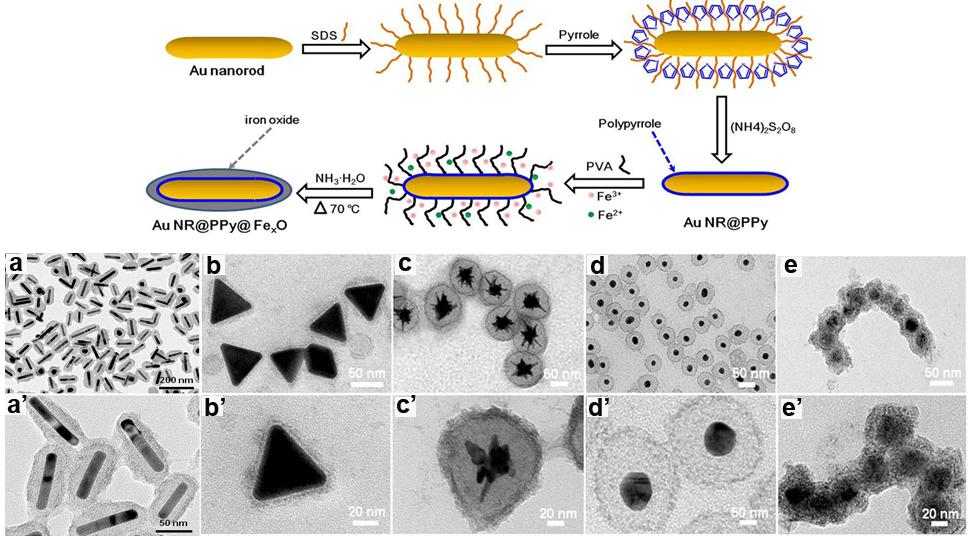Nanocomposites which combine magnetic (e.g., iron oxide) and optically active plasmonic (e.g., Au) components have received widespread attention in recent years due to their potential applications in biomedical research, such as for cancer therapies, as drug-delivery vehicles and imaging contrast enhancing agents. Such nanocomposites, possessing both magnetization and near infrared (NIR) absorption properties, have the potential to substantially improve current cancer therapeutic effect by enabling simultaneous MR imaging and photothermal therapy (theranostics). For best imaging experience, a bright positive contrast signal (T1) is desirable; while for best therapeutic effect, the optical absorption of the nanocomposites needs to be tuned into the NIR region, where the light absorption and scattering is the least through the tissue. Thus, a tailor-made combination of magnetic and optically active plasmonic components is urgently needed for the MRI-guided photothermal nanotheranostic applications.
Recently, Prof. JIANG Jiang’s Lab, at Suzhou Institute of Nano-tech and Nano-bionics, Chinese Academy of Sciences, developed a general method to simultaneously integrate optically active plasmonic component and iron oxide into a multifunctional theranostic platform for T1-MRI imaging guided photothermal therapy.
Using Au nanorods (Au NR) as the core material, a conjugated polymer polypyrrole (PPy) was used to encapsulate Au NRs and obtain Au NR@PPy first by surfactant-assisted chemical oxidative polymerization. Then, a large number of iron oxide nanocrystals were formed on the surface of Au NR@PPy nanoparticles, in the presence of Fe2+ and Fe3+ under alkaline conditions. The resulting Au NR@PPy@FexO nanocomposites exhibit low r2/r1 ratio at 4.8, excellent NIR photothermal conversion efficiency (46%) and biocompatibility, making them promising theranostic agents for simultaneous T1-MR imaging and photothermal therapy.
The synthetic strategy using the thin conjugated polymer polypyrrole as the mid cohesive layer is not limited by the morphology or the composition of the core materials, as Au nanocrystals of varying shapes and transition metal selenide semiconductors such as Cu2-xSe have all been successfully encapsulated by FexO with PPy as the interlayer. This work has been recently published in Nano Research, 2016, 9(3): 787–799.
This work was supported by the “Hundred Talents” program of Chinese Academy of Sciences, and Natural Science Foundation of China (grant no. 21175148 and 21473243).

Figure 1. (Top) Schematic diagram illustrating the synthesis of Au NR@PPy@FexO nanocomposites. (Bottom) TEM images at different magnifications of the as-synthesized nanocomposites with (a) Au nanorod, (b) Au nanoplate, (c) Au nanostar, (d) Au nanoparticle, and (e) Cu2-xSe nanoparticle as the core materials, respectively.(Image by SINANO)

Figure 2. T1 (a) and T2 (b) relaxation rate of the Au NR@PPy@FexO nanocomposites as a function of the iron concentration. (c) Temperature change versus concentration of Au NR@PPy@FexO nanocomposites after being exposed to 1064 nm laser at 1 W/cm2 for 5 min.(Image by SINANO)
Contact information:Prof. JIANG Jiang
Suzhou Institute of Nano-Tech and Nano-Bionics ,Chinese Academy of Science
Suzhou, Jiangsu 215123, China.
E-mail: jjiang2010@sinano.ac.cn

